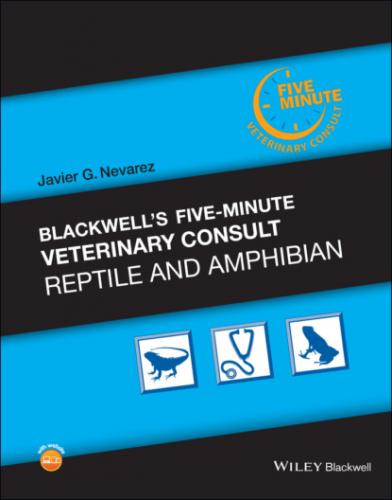PRECAUTIONS/INTERACTIONS
N/A
PATIENT MONITORING
Monitor glucose levels and clinical signs.
EXPECTED COURSE AND PROGNOSIS
If related to nutritional status prognosis is good.
If secondary to severe systemic disease prognosis is poor.
COMMENTS
N/A
ZOONOTIC POTENTIAL
N/A
SYNONYMS
N/A
ABBREVIATIONS
PO = per os
SC = subcutaneous
INTERNET RESOURCES
Kaplan M. Hypoglycemia and Hyperglycemia in Reptiles. Melissa Kaplan’s Herp Care Collection, January 1, 2014. www.anapsid.org/diabetes.html .
Suggested Reading
1 Campbell TW. Clinical pathology. In: Mader DR, Divers SJ, eds. Current Therapy in Reptile Medicine and Surgery. St. Louis, MO: Elsevier; 2014:70–92.
2 Stahl SJ. Hyperglycemia in reptiles. In: Mader DR, ed. Reptile Medicine and Surgery. 2nd ed. St. Louis, MO: Elsevier Saunders; 2006:822–830.
Author Mads F. Bertelsen, DVM, DVSc, DACZM, DECZM (Zoo Health Management)
Hypovitaminosis A
DEFINITION/OVERVIEW
Hypovitaminosis A is a well‐recognized health concern in pet carnivorous, insectivorous, and omnivorous chelonians. The primary cause is feeding food items deficient in the correct form of vitamin A for the species or in under/incorrectly supplementing vitamin A.
ETIOLOGY/PATHOPHYSIOLOGY
In vertebrates, vitamin A forms are trans‐ retinyl esters, trans‐retinol, ‐retinal and ‐retinoic acid (99% of all vitamin A present in body), while the major dietary provitamin A carotenoid is beta carotene.
The all‐trans‐vitamin A isomers are the only forms used physiologically.
Carnivores, insectivores, and possibly omnivores need these forms in their diet.
While reptile herbivores can convert carotenoids lutein and canthaxanthin into trans‐retinyl esters, beta carotene does not convert as well.
Hypovitaminosis A in herbivores is extremely unlikely, excepting after long periods of anorexia.
The liver absorbs and stores preformed vitamin A. Other storage sites include adipose, lung, and kidney.
In humans, retinoid delivery pathway to tissues involves primarily retinol bound to retinol‐binding protein; chylomicrons, very low density lipoprotein, low density lipoprotein, and albumin also provide transport.
Adverse effects in humans include night blindness, impaired immune function, cancer, and birth defects.
SIGNALMENT/HISTORY
First‐time owner of reptiles/species.
Supplementing with beta carotene‐based vitamin A or no supplementation.
Box turtles (Terrapene carolina sp.) and sliders (Trachemys scripta sp.) may present more commonly.
CLINICAL PRESENTATION
Most present with non‐specific signs such as anorexia, dehydration, and lethargy.
Upper respiratory signs include bilateral nasal–ocular discharge, blepharedema, conjunctivitis, “pus” in conjunctival sacs (actually desquamated debris), swelling and closure of palpebral fissures due to squamous metaplasia and glandular hypertrophy, and secondary bacterial infections.
Ulcerative stomatitis, glossal plaques, and glossitis may also be observed.
Chelonian aural abscesses do not appear to be directly associated with hypovitaminosis A based on current findings, but squamous
metaplasia may lead to secondary aural infections.
RISK FACTORS
Husbandry
Insectivore, carnivore not receiving vertebrate prey with liver.
Others
N/A
DIFFERENTIAL DIAGNOSIS
Bacterial infection
Hepatic/renal disease
UVB/thermal burns
Ocular trauma
Water‐based toxins
Poor overall husbandry/diet
Improper conspecific arrangement
Metabolic bone disease
DIAGNOSTICS
Presumptive diagnosis is based upon history, clinical presentation, and response to correct supplementation.
Liver biopsy for histopathology and testing vitamin A levels can be performed, but there is a lack of normal values.
Hepatic vitamin A levels are normally extremely high in carnivores, much lower in herbivores, and intermediate in insectivores and omnivores.
Sex of animal, testing methodology, and reported units can affect results.
PATHOLOGICAL FINDINGS
Squamous metaplasia
Epidermal ulceration
APPROPRIATE HEALTH CARE
N/A
